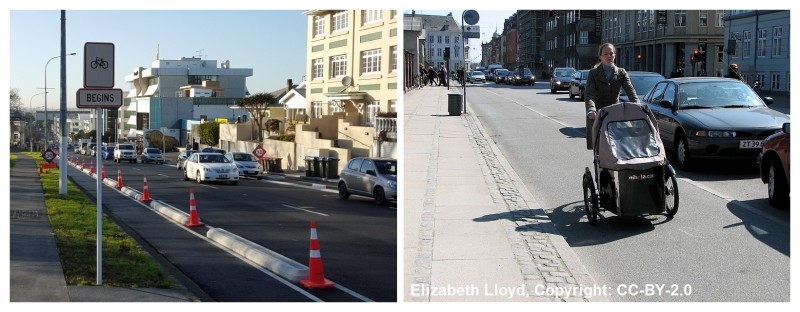A little while ago, one of our at-times-supporters-at-times-critics expressed frustration on social media about why New Zealand keeps insisting on “trialling” cycle infrastructure that is well-established overseas. Instead of responding with the usual answers (legal factors, our drivers not being used to such infrastructure, etc), this time we responded with what we think is the (other) real reason:
It’s to get Kiwis who aren’t reading cycling blogs – and who haven’t cycled overseas either – used to these “new” things.
In other words, trialling new designs is a way of convincing the doubters. By trialling things, you’re not simply “testing” how they work, but engineering acceptance that they work. Among funders, designers, politicians – decision-makers most of all.
“See?” one can say after a trial, “It works here too, even though we’re not Holland!”
Of course, the downside of this approach is that often we end up proceeding by half-steps – fully knowing where we eventually want to be, yet not quite getting there (yet).
- STEP 1: We start with the idea that cyclists deserve some dedicated space on the road – so we add painted lanes. At this point, we’re fighting for the mere right to the space, making a stand against accusations that bike lanes slow other traffic down, etc. And wherever we lose the fight, we try to be graceful about the shared paths we get instead.
- STEP 2: After more gruelling years of work and protest and more cycling and so on, we work our way up to the acceptance that we should really protect soft human bodies from hard metal boxes, and that people on bikes deserve better than they’ve had to date. So we start getting kerbs between bikes and cars, with bike paths sometimes squeezed in as two-way paths on one side of the road, enven though we know better solutions have been found elsewhere many decades ago, namely…
- STEP 3: We push for a move away from “fitting-around-what’s-already-there” and instead demand more dedication, more quality and proper new-builds rather than retrofits. We arrive at real Copenhagen lanes, one-way on each road side, separate from car lanes and pedestrian paths both – and wide enough to allow for some growth in the numbers of people cycling!
As advocates, our hopes and dreams are firmly fixed on Step 3. Right now, the builders of our cycleways are at last moving more and more from Step 1 to Step 2. Which is all the more reason to encourage our cycleway designers to move from Step 2 to Step 3.
Because even with the current boost in cycleway funding and the new energy and enthusiasm for cycling, we need to keep pushing the boundaries on projects that still can easily take 1-2 years in preparation alone. That’s the nub of it: what gets built today was being designed (at least in spirit) several years ago. And what gets designed and approved today is what you will be riding on in 2017 and 2018!
On that note, let’s talk about an aspect of the existing protected cycle lanes in the “Auckland style” – many dozens of which are to be found in various planning and design documents, just waiting to be turned into reality across all the city.
Those kerb dividers. Those bloody things.
What? Do I hear you say that right? Didn’t we just spend years fighting to get proper separation from traffic???
True, true! They’re perfect Step 2 material! And they’re massively better than a painted line on the road surface. But they have a number of issues, of which we’re going to see a lot more, in the coming years. And yet they also have some advantages over both Step 1 AND Step 3 infrastructure (which is why we are using them right now, in the “Step 2 World” we still live in).
Let’s show some images and make a table (who doesn’t like a good table? Click to see a bigger version) of the pros and cons:

So there you have it. Our “Auckland-style” cycle lanes are a good thing… for now. But they remain an interim solution, with a couple of key issues: the main ones being that they are a bit clunky and that they limit the amount of space available for future cycle growth.
Let’s keep up the progress and look forward to our first real Copenhagen lanes. Arguably, Albany Highway comes close, and should be finished next year. And who knows what else is in the pipeline?




